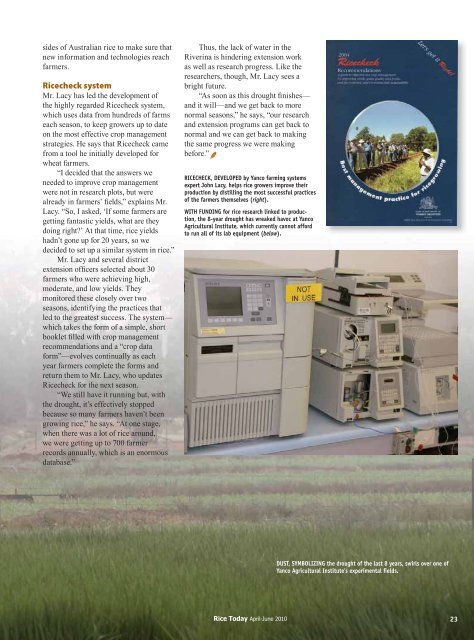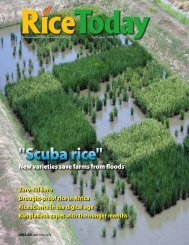JOHN LACY, <strong>in</strong>dustry leader (rice farm<strong>in</strong>g systems)at Yanco Agricultural Institute, helps to l<strong>in</strong>k theRiver<strong>in</strong>a region’s rice farmers with the latestresearch.Dr. Ward notes that this type <strong>of</strong><strong>in</strong>formation <strong>in</strong>forms her work on <strong>gra<strong>in</strong></strong>quality. One <strong>of</strong> her key roles is to supply<strong>gra<strong>in</strong></strong> quality data on breed<strong>in</strong>g l<strong>in</strong>es tothe breeders.“The research is largelyaimed at expand<strong>in</strong>g the scope <strong>of</strong> thequality analysis as well as provid<strong>in</strong>gsuch data for earlier gene rations <strong>of</strong> thebreed<strong>in</strong>g process,” she says. “Ultimately,this work will fast-track the release<strong>of</strong> new varieties that have certa<strong>in</strong>agronomic benefits, such as coldtolerance, but are also ready forconsumers.”Dr. Re<strong>in</strong>ke pays tribute to hispredecessor, Dr. Lew<strong>in</strong>, who, he says,ma<strong>in</strong>ta<strong>in</strong>ed enough diversity <strong>in</strong> the Yancobreed<strong>in</strong>g program to allow as rapid aresponse as possible to new challenges.“We’ve strived to have a mix <strong>of</strong>quality types so that at any po<strong>in</strong>t, whensome new feature is communicated tous, we can identify material that alreadyexists, and we can leap <strong>in</strong> and test it,”says Dr. Re<strong>in</strong>ke. “That circumvents this10-year lag phase from mak<strong>in</strong>g the firstcross all the way through to release.”Less water, more riceBy now, it is probably clear that onethread <strong>in</strong> particular runs through theentire tapestry <strong>of</strong> rice <strong>in</strong> Australia: water.Specifically, us<strong>in</strong>g less <strong>of</strong> it to grow morerice.“Our holy grail <strong>in</strong> terms <strong>of</strong> wateruseefficiency is to be able to use 10megaliters <strong>of</strong> water per hectare,” saysRuth Wade, executive director <strong>of</strong> theRicegrowers’ Association <strong>of</strong> Australia,a voluntary organization made up <strong>of</strong>current and retired rice growers (seeA <strong>sunburned</strong> <strong>gra<strong>in</strong></strong> on pages 12-17).“We were on a nice trajectory <strong>in</strong> thatdirection. Before the drought, it wasabout 12 megaliters, but that’s slowedbecause now it’s tak<strong>in</strong>g a lot <strong>of</strong> water towet up the system. The global average isaround 15–20 megaliters. We aspire toconsistently be<strong>in</strong>g way ahead <strong>of</strong> anybodyelse.”Unsurpris<strong>in</strong>gly, much <strong>of</strong> Yancoagronomist Ge<strong>of</strong>f Beecher’s researchdraws on the same theme. One <strong>of</strong> his keyroles <strong>in</strong> more than 20 years at Yanco hasbeen <strong>in</strong> determ<strong>in</strong><strong>in</strong>g land that is suitablefor rice production. In particular, thismeans relatively impermeable heavyclay soils that m<strong>in</strong>imize seepage <strong>in</strong>towater tables. These days, Australian ricegrowers are permitted to grow rice onsuitable soil only. Further, <strong>in</strong>dividualfarmers cannot grow rice on more than30% <strong>of</strong> their suitable land.More recently, Mr. Beecher hasbeen <strong>in</strong>vestigat<strong>in</strong>g the way that thespatial layout <strong>of</strong> rice land affects waterproductivity.“In any rice field, we get areasthat are highly productive and areasthat aren’t so productive,” he says. “Wethought that productivity might havebeen related to soil type but really it’scome back to cut and fill.”Cutt<strong>in</strong>g and fill<strong>in</strong>g land to make itlevel have been carried out for decadesand, over that time, cutt<strong>in</strong>g depth hasgradually <strong>in</strong>creased. Around 20 yearsago, 10 centimeters would have beenconsidered a big cut; now, some farmersmake half-meter cuts.“Now you’ve got huge differences<strong>in</strong> fertility between cut and filled areas,”says Dr. Beecher. “If you have a naturaltopsoil layer with reasonable organiccarbon, nitrogen, and phosphorus levels,and you come <strong>in</strong> and chop it down 400millimeters, you create an area that’snot a very nice grow<strong>in</strong>g environment.We’re work<strong>in</strong>g on how we can managethe problems caused by these really bigcuts.”Switch<strong>in</strong>g cropsMr. Beecher is also work<strong>in</strong>g on ways <strong>of</strong>sett<strong>in</strong>g up a rice field that allow farmersto switch between crops without hav<strong>in</strong>gto make major changes.“We might be look<strong>in</strong>g at a banklesschannel with raised beds <strong>in</strong>side it and aterraced layout,” he says, “which meansthat a farmer could leave the beds <strong>in</strong>place after a rice crop and then grow aseries <strong>of</strong> upland crops <strong>in</strong> rotation withoutchang<strong>in</strong>g the layout. So, you can <strong>in</strong>creasecropp<strong>in</strong>g <strong>in</strong>tensity and maximize wateruse at the same time.”John Lacy is <strong>in</strong>dustry leader (ricefarm<strong>in</strong>g systems) at Yanco. He acts as thel<strong>in</strong>k between the research and extension22Rice Today April-June 2010
sides <strong>of</strong> Australian rice to make sure thatnew <strong>in</strong>formation and technologies reachfarmers.Ricecheck systemMr. Lacy has led the development <strong>of</strong>the highly regarded Ricecheck system,which uses data from hundreds <strong>of</strong> farmseach season, to keep growers up to dateon the most effective crop managementstrategies. He says that Ricecheck camefrom a tool he <strong>in</strong>itially developed forwheat farmers.“I decided that the answers weneeded to improve crop managementwere not <strong>in</strong> research plots, but werealready <strong>in</strong> farmers’ fields,” expla<strong>in</strong>s Mr.Lacy. “So, I asked, ‘If some farmers aregett<strong>in</strong>g fantastic yields, what are theydo<strong>in</strong>g right?’ At that time, rice yieldshadn’t gone up for 20 years, so wedecided to set up a similar system <strong>in</strong> rice.”Mr. Lacy and several districtextension <strong>of</strong>ficers selected about 30farmers who were achiev<strong>in</strong>g high,moderate, and low yields. Theymonitored these closely over twoseasons, identify<strong>in</strong>g the practices thatled to the greatest success. The system—which takes the form <strong>of</strong> a simple, shortbooklet filled with crop managementrecommendations and a “crop dataform”—evolves cont<strong>in</strong>ually as eachyear farmers complete the forms andreturn them to Mr. Lacy, who updatesRicecheck for the next season.“We still have it runn<strong>in</strong>g but, withthe drought, it’s effectively stoppedbecause so many farmers haven’t beengrow<strong>in</strong>g rice,” he says. “At one stage,when there was a lot <strong>of</strong> rice around,we were gett<strong>in</strong>g up to 700 farmerrecords annually, which is an enormousdatabase.”Thus, the lack <strong>of</strong> water <strong>in</strong> theRiver<strong>in</strong>a is h<strong>in</strong>der<strong>in</strong>g extension workas well as research progress. Like theresearchers, though, Mr. Lacy sees abright future.“As soon as this drought f<strong>in</strong>ishes—and it will—and we get back to morenormal seasons,” he says, “our researchand extension programs can get back tonormal and we can get back to mak<strong>in</strong>gthe same progress we were mak<strong>in</strong>gbefore.”RICECHECK, DEVELOPED by Yanco farm<strong>in</strong>g systemsexpert John Lacy, helps rice growers improve theirproduction by distill<strong>in</strong>g the most successful practices<strong>of</strong> the farmers themselves (right).WITH FUNDING for rice research l<strong>in</strong>ked to production,the 8-year drought has wreaked havoc at YancoAgricultural Institute, which currently cannot affordto run all <strong>of</strong> its lab equipment (below).DUST, SYMBOLIZING the drought <strong>of</strong> the last 8 years, swirls over one <strong>of</strong>Yanco Agricultural Institute’s experimental fields.Rice Today April-June 201023

















